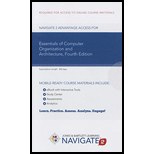
a.
Distributive law:
Consider three variables x, y, and z. The multiplication of variable (x) with the sum of two variables (y and z) is same as the sum of the products (xy and xz).
The representation of distributive law is as follows:
Identity law:
The sum of the variable (x) and the value 0 is “x” and the product of the variable (x) and the value 1 is “x”.
The representation of identity law is as follows:
Inverse law:
The sum of the variable (x) and the complement of the variable (x’) is 1 and the product of the variable (x) and the complement of the variable (x’) is 0.
The representation of inverse law is as follows:
Idempotent law:
The sum of the variable (x) and the same variable (x) is “x” and the product of the variable (x) and the same variable (x) is “x”.
The representation of idempotent law is as follows:
a.
Explanation of Solution
Simplification:
Therefore, the simplified expression is “
b.
Distributive law:
Consider three variables x, y, and z. The multiplication of variable (x) with the sum of two variables (y and z) is same as the sum of the products (xy and xz).
The representation of distributive law is as follows:
Identity law:
The sum of the variable (x) and the value 0 is “x” and the product of the variable (x) and the value 1 is “x”.
The representation of identity law is as follows:
Inverse law:
The sum of the variable (x) and the complement of the variable (x’) is 1 and the product of the variable (x) and the complement of the variable (x’) is 0.
The representation of inverse law is as follows:
De Morgan’s Law:
- The complement of the intersection of two sets is the union of their complements.
- The complement of the union of two sets is the intersection of their complements.
The representation of the De Morgan’s law as follows:
Double compliment law:
The representation of double compliment law is
b.
Explanation of Solution
Simplification:
Therefore, the simplified expression is “
c.
Distributive law:
Consider three variables x, y, and z. The multiplication of variable (x) with the sum of two variables (y and z) is same as the sum of the products (xy and xz).
The representation of distributive law is as follows:
Idempotent law:
The sum of the variable (x) and the same variable (x) is “x” and the product of the variable (x) and the same variable (x) is “x”.
The representation of idempotent law is as follows:
Null law:
The sum of the variable (x) and the value 1 is “1” and the product of the variable (x) and the value 0 is “0”.
The representation of null law is as follows:
Identity law:
The sum of the variable (x) and the value 0 is “x” and the product of the variable (x) and the value 1 is “x”.
The representation of identity law is as follows:
c.
Explanation of Solution
Simplification:
Therefore, the simplified expression is “
Want to see more full solutions like this?
Chapter 3 Solutions
Navigate 2 Advantage Access for Essentials of Computer Organization and Architecture
 Database System ConceptsComputer ScienceISBN:9780078022159Author:Abraham Silberschatz Professor, Henry F. Korth, S. SudarshanPublisher:McGraw-Hill Education
Database System ConceptsComputer ScienceISBN:9780078022159Author:Abraham Silberschatz Professor, Henry F. Korth, S. SudarshanPublisher:McGraw-Hill Education Starting Out with Python (4th Edition)Computer ScienceISBN:9780134444321Author:Tony GaddisPublisher:PEARSON
Starting Out with Python (4th Edition)Computer ScienceISBN:9780134444321Author:Tony GaddisPublisher:PEARSON Digital Fundamentals (11th Edition)Computer ScienceISBN:9780132737968Author:Thomas L. FloydPublisher:PEARSON
Digital Fundamentals (11th Edition)Computer ScienceISBN:9780132737968Author:Thomas L. FloydPublisher:PEARSON C How to Program (8th Edition)Computer ScienceISBN:9780133976892Author:Paul J. Deitel, Harvey DeitelPublisher:PEARSON
C How to Program (8th Edition)Computer ScienceISBN:9780133976892Author:Paul J. Deitel, Harvey DeitelPublisher:PEARSON Database Systems: Design, Implementation, & Manag...Computer ScienceISBN:9781337627900Author:Carlos Coronel, Steven MorrisPublisher:Cengage Learning
Database Systems: Design, Implementation, & Manag...Computer ScienceISBN:9781337627900Author:Carlos Coronel, Steven MorrisPublisher:Cengage Learning Programmable Logic ControllersComputer ScienceISBN:9780073373843Author:Frank D. PetruzellaPublisher:McGraw-Hill Education
Programmable Logic ControllersComputer ScienceISBN:9780073373843Author:Frank D. PetruzellaPublisher:McGraw-Hill Education





